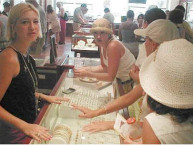Turquoise
Turquoise is actually a mineral, possibly one of the most valuable minerals. Its color is of course “turquoise” but this color actually varies from greenish blue to sky blue shades. It is non-transparent and has been mined and fashioned into jewelry for thousands of years. There is proof of the Egyptians mining turquoise around 6,000 BC. Some of the finest turquoise in the world comes from Persia. The name comes from a French word which means stone of Turkey, from where Persian material passed on its way to Europe.
Good turquoise is of a beautiful blue color. Poor turquoise is lighter in color, sometimes almost white, and quite soft. The lower grades of lighter colored stones are often oiled: that is the stone is placed in a bath of hot mineral oil, which brings them somewhat up to the color of the better grade. There is no certain way of telling whether or not a stone in a piece of jewelry is oiled except that, in time, the oil dries out and the stone finally reverts back to its original color.
The best turquoise today comes from Nevada. It is formerly mined in New Mexico, but only a few mines are still in operation in that state. The stone still is mined in a primitive manner by breaking it out of rock with a pick or a hammer and chisel.
Some turquoise is found in the form of beautifully clear blue nuggets without any matrix, while others contain quite a bit. Another important feature in turquoise is hardness. Some pieces are so soft they can be cut with a knife. That kind of stone is not worth setting in silver. Good turquoise is quite hard, and will not scratch easily with everyday wear. This is where it pays to buy from a reliable source.
The people most famous for fashioning this mineral into wonderful works of art are the American Indians. The American Indians were deeply spiritual, worshiping the earth and nature.  They held the products of the Earth in high esteem, as gifts of Nature. Part of that spirituality was expressed in the creation of fine turquoise pieces.
They held the products of the Earth in high esteem, as gifts of Nature. Part of that spirituality was expressed in the creation of fine turquoise pieces.
The commercial Indian Jewelry craze began in the 1920’s, when the Harvey House restaurant chain opened during the great days of rail travel in the US. At first, Indian Jewelry was only sold as curios in the restaurants for patrons touring the west. Earrings and thin, small bracelets stamped with arrows and bows and containing oval pieces of turquoise were most in demand. Heavy Indian Jewelry was not popular until 1925, when the classic squash-blossom necklaces were first brought to the tourist market. The squash-blossom craze lasted until 1940, when they were discontinued by the Indian artisans for requiring too much work and too much turquoise.
In the 1920’s and 1930’s, the concho belt changed from a simple silver belt to a belt with turquoise stones not only in the buckle but also turquoise in the butterfly- the spaces between the conchos. The tourist jewelry of that era is highly collectable today.
In the years following WWII, many Americans traveled across the country and on their trips to the Southwest and other areas inhabited by American Indians, discovered that “traders” had rooms full of the Indians old personal jewelry, which the “traders” called “pawn pieces.” Most of these are jewelry pieces the Indian people made for themselves and pawned for two reason: they needed money, and it was a safe storage place.
As a result of the popularity of the pawn pieces, a host of “trading posts” sprang up in the Southwest. During this time, which extended to the early 1950’s, turquoise was named, for sales purposes, after the mines in which it was found: Bisbee, Castle Dome, Nevada Green, and others. The names have become so standardized over the years that they now have little to do with the mines, or even the original color of the turquoise.
For example, Bisbee turquoise originally had a brown matrix. The Bisbee that is mined today has no brown matrix, although the mine is still active, it has a high blue color.
Today’s turquoise is mostly treated with plastic bonding, chemical vapor penetration, paraffin or some other stabilizing agent to help the material retain its bright color. It is estimated that only 25% of mined turquoise can be used without treating. Without treatment most turquoise will change from blue to green over the years, owing to the porous nature of the material.
 Although some American Indians continued to handcraft silver jewelry in the 1960’s in the traditional way, their work was not widely popular until the late 1960′ and early 1970’s. This is when the craze for Indian jewelry reached such proportions, that increased demand lead to the import of “Indian Jewelry” from manufacturers in Mexico, Taiwan, and the Philippines. The market became glutted and by 1981 the supply was high but the demand was gone.
Although some American Indians continued to handcraft silver jewelry in the 1960’s in the traditional way, their work was not widely popular until the late 1960′ and early 1970’s. This is when the craze for Indian jewelry reached such proportions, that increased demand lead to the import of “Indian Jewelry” from manufacturers in Mexico, Taiwan, and the Philippines. The market became glutted and by 1981 the supply was high but the demand was gone.
A few of the exceptionally talented American Indian silversmiths used their profits wisely to develop new concepts and techniques in American Indian Jewelry design. The result is that now there are two kinds of jewelry for sale. The first category includes signed, hand-made silver and gold jewelry, often set with turquoise, lapis lazuli and even diamonds. These are contemporary in design, unlike the original American Indian Jewelry. The second category includes production work—Navajo, Hopi, and Zuni—which is characterized by new designs in silver and the use of more stones.
Navajo jewelry is distinguished by its simplicity and sparing use of turquoise or other stones. The Navajos are silversmiths. Their famous squash-blossom beads are not symbols of fertility—a romantic notion perpetuated by traders—but adaptations of Spanish ornaments, which were shaped like pomegranates. The dangling Najas, crescent shapes, were also borrowed from the Spaniards, who in turn had adapted the shape from African charms used to ward off the “evil eye.”
beads are not symbols of fertility—a romantic notion perpetuated by traders—but adaptations of Spanish ornaments, which were shaped like pomegranates. The dangling Najas, crescent shapes, were also borrowed from the Spaniards, who in turn had adapted the shape from African charms used to ward off the “evil eye.”
The Zunis learned how to work silver from the Navajos, but their primary interest is lapidary. They are stonecutters and stoneworkers. In Zuni-designed jewelry, metal serves primarily as a support for colored stones. Designs are often so ornate that little silver is visible.
The Hopis used turquoise sparingly and their contribution to Indian jewelry and the most popular styles was developed after 1930. They use an overlay technique in which two sheets of silver are sweat-soldered together. The top or overlay has a cutout design, and the area directly beneath the design (on the bottom silver) is oxidized, creating a contrast between bright and dark silver. Traditionally Hopi designs were drawn from pottery decoration.
The Santo Domingo Indians are known for making find beads called hishi. Turquoise, clam, and other shells are drilled, strung together, and rolled over to produce smooth and round edges. This tribe also includes silver in their necklaces.
Elements in valuing old Indian Jewelry include the following: Age, Patina, Workmanship, Weight of the Silver, Quality of the Stones (if any), Classic Design. The simplicity of design was one factor that made American Indian jewelry valuable to non-Indians.
Elements in valuing contemporary Indian Jewelry Include: Metals, fineness of Metal and weights. Signature, Quality, Wear-ability. ( Some pieces are simply too large or heavy to be worn comfortably)
 Finely crafted Indian jewelry will have a wonderful feel about it. The edges will be smooth, with no porosity to the metal. Most sought after are the hand signed pieces directly from the artist. You often can find these pieces at very reasonable prices. If that artists pieces become very popular, the value of your piece foes up as well. However, we strongly urge people not to buy jewelry as an investment. Jewelry should be bought for the enjoyment, and how it augments your lifestyle.
Finely crafted Indian jewelry will have a wonderful feel about it. The edges will be smooth, with no porosity to the metal. Most sought after are the hand signed pieces directly from the artist. You often can find these pieces at very reasonable prices. If that artists pieces become very popular, the value of your piece foes up as well. However, we strongly urge people not to buy jewelry as an investment. Jewelry should be bought for the enjoyment, and how it augments your lifestyle.
There is a lot of counterfeit American Indian jewelry still on the market. The American Indian Arts and Crafts Association has attempted over the last several years to require labeling on foreign counterfeit American Indian-style goods. In 1985, more than two hundred American Indian artisans, backed by two Congressmen, filed a class action request with the US customs requiring a clear, indelible, and permanent labeling on the imitation jewelry. They requested that all such imported items to be marked “Imported.”
How to care for Turquoise Jewelry:
Turquoise is treated to stabilize the color, so avoid ultrasonics. Turquoise is porous, so contact with liquids, oils or even perspiration should be avoided. Jewelry made with turquoise should be removed before washing hands, etc.. Turquoise is somewhat soft so avoid scratches and sharp blows. To be certain and coatings are not removed also avoid hot water and household chemicals.
Folklore and Legends:
The Navaho believe turquoise is a piece of the sky which has fallen to earth. Each Navajo Indian would carry a personal turquoise. It was believed that turquoise thrown into a river would bring rain. Pieces were placed in door lintels to guard against evil spirits.
Because of its spiritual value, many tribes used turquoise as a common medium of exchange.
The Apache think it combines the spirits of the sea and sky to helped warriors and hunters aim accurately. They called it “duklij”; meaning either a green or blue stone; like the ancient Greeks, they did not distinguish these colors from each other.
The Zuni believe that turquoise protects them from demons, while the Aztecs reserved turquoise for the gods and was not to be worn by mere mortals. Montezuma’s treasure, now displayed in the British Museum in London, includes a carved serpent covered by a mosaic of turquoise.
Turquoise has been thought to warn the wearer of danger or illness by changing color.
In the 13th century, Turquoise was thought to protect the wearer from falling especially from horses.
Legend has it that the Indians believed that if turquoise was affixed to a bow, the arrows shot from it would always hit their mark. It was also believed to bring happiness and good fortune to all.
Hindus believed that it is very lucky to look at turquoise immediately after looking at a new moon. In Persia, this belief was slightly altered: it is lucky to see the reflection of the new moon in a turquoise.
Middle Eastern tradition insisted that the turquoise would guard against accidents, specifically those caused by falling. Turquoise was used as a horse amulet, to prevent horses or their riders from falling down.
Europeans copied the tradition to some extent, allowing that, while a fall might occur, a wearer of the turquoise would never suffer broken limbs. Emperor Charles V’s court jester made a famous joke on the subject: “If you should happen to fall from a high tower whilst you were wearing a turquoise on your finger, the turquoise would remain unbroken.”
Arabians thought the turquoise would warn of approaching danger by changing color. It is true that the color of some turquoise is easily disturbed by heat, sunlight, moisture, dryness, oil, perspiration, or simply by washing hands while wearing a turquoise. The basic color is variable, also. The color may be any shade between blue and green, the blue contributed by the copper content and the green by traces of ferric iron.
Dr. Fernie thought the phosphates in turquoise might serve to “confer fresh brain-powers.” But if exposing the skin to some kind of phosphate were all that is needed for development of a powerful brain, then surely our most intelligent individuals would be those who routinely handle fertilizers.
It is the state stone of Arizona, New Mexico and Nevada.
Turquoise Mystical Properties:
Tradition says that Issac; the son of Abraham, was the first to open the famed Persian Turquoise mines. Although, various versions of the Bible disagree, some scholars believe the gem was one of the precious stones that comprises the foundation of the New Jerusalem.
In ancient lore, the beautiful blue color of the Turquoise represented the atmosphere surrounding the earth, which was the giver of life and breath. The stone further signified man’s origin as a creature of the spirit rather than of flesh.
A belief that Turquoise brought good luck was prevalent during the time of Shakespeare. Also superstition alluded to the belief that the stone grew pale when its owner took sick and lost its color completely at death. Turquoise would regain its color however, if it was worn by a new and healthy owner.
Today the American Indian reveres Turquoise for its balancing and healing energies. It is said to act as a unifying force between the Spirit of air and the Spirit of the Earth.
It helps the wearer to start new projects. It is a profound master healer and will relieve excessive mucus in the body. It also attracts new friends and lovers, money, and happiness; guards against accidents, poison, violence, migraines, snakes and all diseases.



